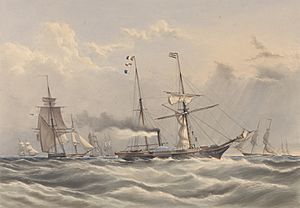Experimental Squadron (Royal Navy) facts for kids
The Experimental Squadrons were special groups of ships in the Royal Navy during the 1830s and 1840s. Their main job was to test out new ideas for building ships, new weapons, and new ways of making ships move (like steam power). They would compare these new designs against older, more traditional ships.
These squadrons were created because there were different ideas about how to build the best ships. Some people, like William Symonds, believed in building ships based on practical experience. Others, from the first School of Naval Architecture, thought ship design should be based on science. And then there were the traditional shipbuilders who preferred older methods.
Contents
Testing New Ship Designs
Early Trials: 1831–1832
In 1831, Admiral Edward Codrington put together a "Squadron of Evolution." This group of ships was meant to test new shapes for ship hulls (the main body of the ship). At first, the squadron was sent near the coast of Belgium to encourage French ships to leave. Later, these ships helped a British squadron near Lisbon, Portugal, during a civil war there.
More Tests in 1832
The Experimental Squadron, led by Sir Pulteney Malcolm, carried out more tests in July and August 1832. They held trials off the coast of Ireland and near the Scilly Islands. One interesting test on July 13 was a race between a British Navy cutter called Emerald and a ship named Paddy from Cork. Paddy, which had recently been made longer, won the race by about a mile!
The 1844 Squadron
In 1844, a new government group called the Board of Admiralty wanted to show that William Symonds' ship designs were not good. So, they sent out more "Experimental Squadrons."
On October 22, 1844, a squadron of smaller ships called brigs left Portsmouth. This group included Symonds' ships Pantaloon and Flying Fish, along with older ships like Cruiser and others. Three days later, a squadron of larger ships called ship of the lines also set sail. This group was led by Rear-admiral William Bowles and included older three-deckers like Caledonia and St Vincent, plus Symonds' three-decker Queen.
Symonds' two-decker ship, Albion, joined the larger ships in Lisbon. All four ships returned to Portsmouth on November 27, nine days before the brig squadron.
The 1845 Squadrons
The next year, on July 15, 1845, Rear-Admiral Hyde Parker led another squadron from Portsmouth. This group included older ships like Trafalgar and Canopus, as well as Symonds' designs like Queen, Albion, Vanguard and Superb. They sailed to Cork and then to Plymouth. Interestingly, the ship Queen did very well in these 1845 tests, even though it hadn't performed as well in 1844.
In Plymouth, the same squadron was then led by Rear-Admiral Sir Samuel Pym. They sailed again and returned to Plymouth in December. The third and final cruise of 1845 lasted 43 days. It only included the two-decker ships from the earlier cruises (Albion, Vanguard, Superb, Rodney, and Canopus), plus a brig from the 1844 squadron, Daring. This cruise was led by experienced captains who acted as a commodore, which is a senior officer in charge of a group of ships.
The 1846 Cruises
The last set of cruises happened from April to July 1846. Commodore Sir Francis Collier led a "squadron of evolution" from Cobh, Ireland. This squadron was a mix of traditional sailing ships and newer steam-powered ships.
The sailing ships included: HMS St Vincent, HMS Trafalgar, HMS Queen, HMS Rodney, HMS Albion, HMS Superb, HMS Raleigh, HMS Vanguard, HMS Belleisle, and HMS Brilliant.
The steam-powered ships, which used paddle wheels or early propellers, included: HMS Retribution, HMS Gladiator, HMS Scourge, HMS Devastation, HMS Cyclops, and HMS Rattler. The Rattler was very important because it was the Navy's first ship to use a screw propeller for propulsion!
What Were the Results?
The tests in the 1840s were sometimes affected by things that weren't fully understood at the time. For example, a ship's performance could depend on the captain's personal opinions or even how cargo was stored on board. Because these outside factors weren't always considered, the results weren't always clear. In October 1847, William Symonds decided to leave his role as Surveyor of the Navy. This happened after the Board of Admiralty created a special committee to oversee his designs and make changes to them.
Who Led the Squadrons?
Here are some of the important commanders who led the Experimental Squadrons:
| Rank | Name | Date |
|---|---|---|
| Vice-Admiral | Sir Edward Codrington | 1831 |
| Vice-Admiral | Sir Pulteney Malcolm | 1832 |
| Captain | Armar Lowry Corry | 1844 |
| Rear-Admiral | Hyde Parker | 1845 |
| Rear-Admiral | Sir Samuel Pym | 1845 |
| Commodore | Fairfax Moresby | 1845 |
| Commodore | George Willes | 1845 |
| Commodore | Francis Collier | 1846 |


